Robert Adam George III Silver Gilt Vase by Daniel Smith and Robert Sharp London
£12,500
Follow Us
Robert Adam George III Silver Gilt Vase by Daniel Smith and Robert Sharp London
A fine and rare 18th century George III silver-gilt vase by Daniel Smith and Robert Sharp, London 1770. Based on a design by the Italian printmaker Stefano della Bella (1610-1664). The design was adapted by the architect Robert Adam (1728-1792).
The overall form of the vase and some of the ornaments, such as the drapery swags, figural masks and acanthus leaves on the body, are based on a design by the Italian printmaker Stefano della Bella (1610-1664). He produced about 1,400 prints during his lifetime which were very influential, particularly a series of designs for vases in Raccolta di Vasi Diversi, published between 1639 and 1648. The design was adapted by the architect Robert Adam (1728-1792), whose drawing, now in Sir John Soane’s Museum in London and was copied by the highly-fashionable silversmithing partnership Daniel Smith and Robert Sharp.
Daniel Smith and Robert Sharp’s partnership ran from 1763-1788. They supplied high-quality silver and silver gilt in the Neo-classical style to the most fashionable retailers and clients, including the Prince Regent. They were the principal manufacturers of a series of magnificent race cups, one of which was designed by the architect Robert Adam (1728-1792) and another is in the Royal collection
Robert Adam (1728-1792) was arguably the most famous eighteenth century British architect and designer, whose remarkable career in partnership with his brothers James and William has been thoroughly documented elsewhere and whose major commissions can still be seen at Harewood House, Kedleston Hall, Kenwood, Syon House and Osterley Park. Robert established his business in London after a Grand Tour study visit of Paris and Italy from 1754-1758 and in 1761 he was appointed architect of the King’s Works.
Robert is probably best known for his collaboration with Thomas Chippendale which resulted in some of the finest neo-classicist designs of the time, most notably at Harewood House. He also collaborated with John Linnell, Ince and Mayhew, Vile and Cobb, Daniel Smith and Robert Sharp, John Parker and Edward Wakelin.
Dimensions: 21.5cm., 8 ½in. high
Weight: 630gr., 20 ½oz.
Marked on the Base and cover
The vase was arguably the most fashionable interior design accessory of the late 18th century with the silver-gilt variant being at the top of the market, and a distinctive icon of the Neo-classical style. Inspired by the revival of interest in the antique world, the vase was often based, as here, on engraved design sources.
Further reading
A silver vase by John Parker and Edward Wakelin of the same scale, design and date is currently on display at the Victoria and Albert Museum, South Kensington (see the last image in photos.) Accession number: 564:1, 2-1874
A horse racing trophy in the form of a silver gilt two-handled cup and cover Presented to Sir William Foulis and Tatton Sykes as the owners of Trajan, winner of the Handicap Plate at Lincoln, 25 June 1813. Bequeathed to Queen Victoria by Christopher Sykes, 1898. The Royal Collection Trust: RCIN 50266
It should be noted that this is quite simply a masterpiece of museum grade.
Condition
Good. Wear consistent with age and use.
Dimensions
Height: 53.34 cm (21 in)
Diameter: 8.89 cm (3.5 in)
PREVIOUSLY SOLD
No Results Found
The page you requested could not be found. Try refining your search, or use the navigation above to locate the post.
No Results Found
The page you requested could not be found. Try refining your search, or use the navigation above to locate the post.
YOU MAY ALSO LIKE
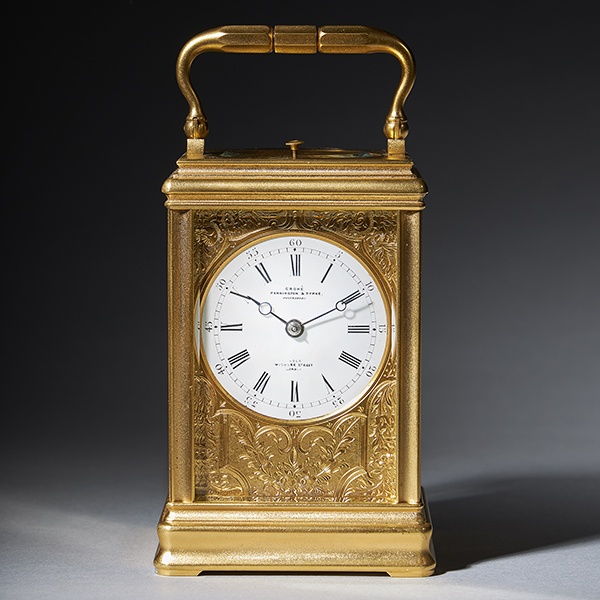
19th Century Repeating Gilt-Brass Carriage Clock by the Famous Drocourt
19th Century Repeating Gilt-Brass Carriage Clock by the Famous Drocourt £5,600 Follow Us19th Century Repeating Gilt-Brass Carriage Clock by the Famous Drocourt A superb repeating carriage clock with a gilt-brass gorge case by the famous maker...
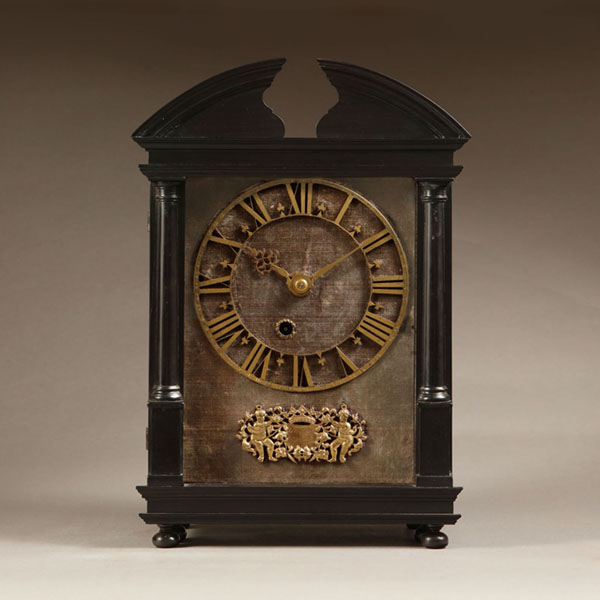
17th-Century Hague Clock Signed by Pieter Visbagh, circa 1675
Small 17th Century Hague clock made c. 1675 by Pieter Visbagh, who was apprenticed by Salomon Coster. The latter made the first pendulum clock according to the instructions of Christiaan Huygens, the internationally renowned scientist who developed the idea of applying a pendulum to a clock movement.
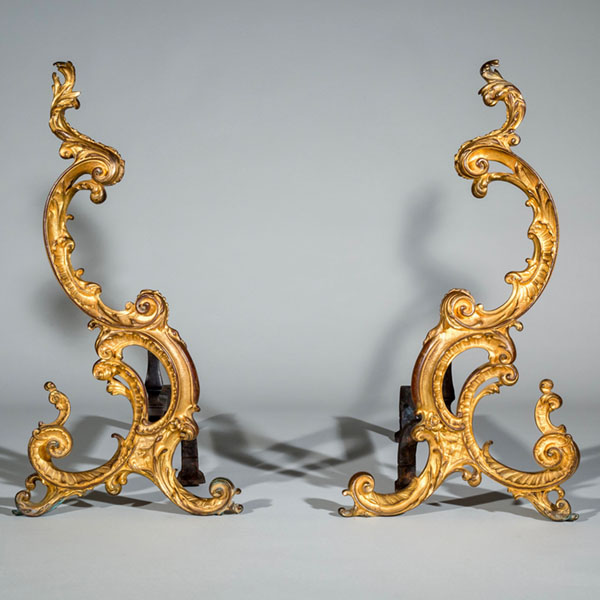
Pair of 18th-Century English Rococo Gilt Bronze Andirons or Firedogs
An exceptional pair of 18th century English Rococo gilt bronze andirons or fire dogs.
The bold shape of these andirons relate to designs of Thomas Johnson (1714–1778), one of London’s pioneers of the ‘Modern’ or French style, later known as Rococo.
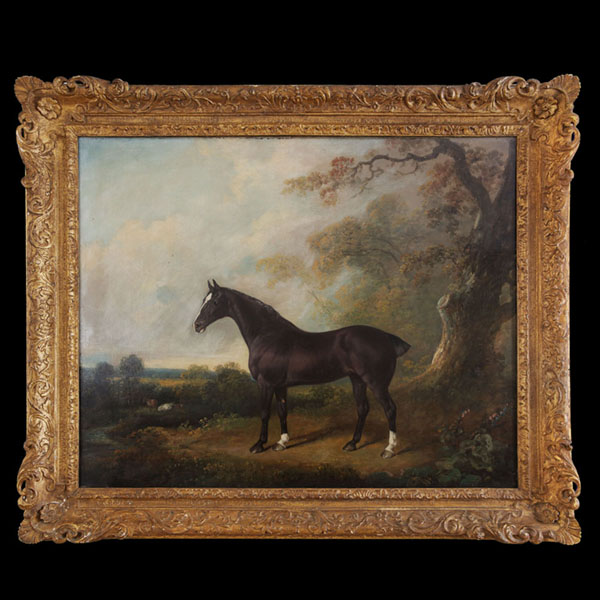
Oil Painting of a Horse Standing Proud in Woodland
Fine Art – Charles Henry Scwanfelder (1774-1837). Signed C H Schwanfelder Pinx and dated 1825. An exceptional portrait of a horse standing proud in woodland, in front of a tree-lined vista incorporating cows residing by a stream.
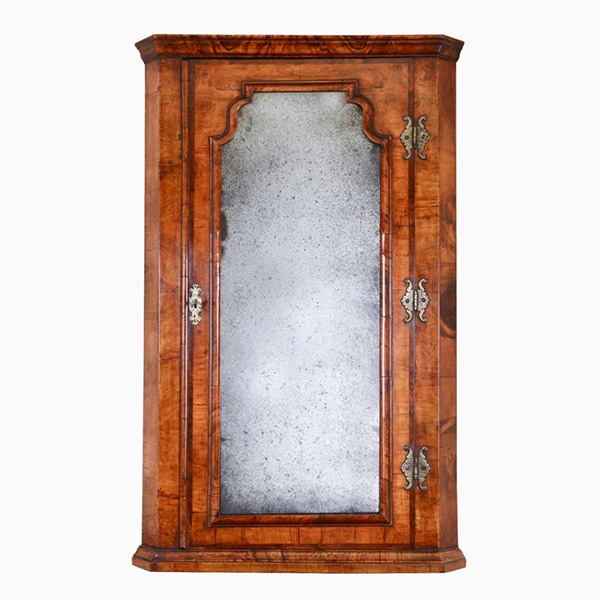
Queen Anne Walnut Corner Cupboard with Bevelled Mirror Plate
A truly remarkable find in original condition. To the door a shaped soft bevelled mirror plate is framed by a cross-grain molding of typical queen Anne design which is further cross-banded, feather-banded and edged to the opening with a single de-molding.

19th Century Repeating Gilt-Brass Carriage Clock by the Famous Drocourt
19th Century Repeating Gilt-Brass Carriage Clock by the Famous Drocourt £5,600 Follow Us19th Century Repeating Gilt-Brass Carriage Clock by the Famous Drocourt A superb repeating carriage clock with a gilt-brass gorge case by the famous maker...

17th-Century Hague Clock Signed by Pieter Visbagh, circa 1675
Small 17th Century Hague clock made c. 1675 by Pieter Visbagh, who was apprenticed by Salomon Coster. The latter made the first pendulum clock according to the instructions of Christiaan Huygens, the internationally renowned scientist who developed the idea of applying a pendulum to a clock movement.

Pair of 18th-Century English Rococo Gilt Bronze Andirons or Firedogs
An exceptional pair of 18th century English Rococo gilt bronze andirons or fire dogs.
The bold shape of these andirons relate to designs of Thomas Johnson (1714–1778), one of London’s pioneers of the ‘Modern’ or French style, later known as Rococo.

Oil Painting of a Horse Standing Proud in Woodland
Fine Art – Charles Henry Scwanfelder (1774-1837). Signed C H Schwanfelder Pinx and dated 1825. An exceptional portrait of a horse standing proud in woodland, in front of a tree-lined vista incorporating cows residing by a stream.

Queen Anne Walnut Corner Cupboard with Bevelled Mirror Plate
A truly remarkable find in original condition. To the door a shaped soft bevelled mirror plate is framed by a cross-grain molding of typical queen Anne design which is further cross-banded, feather-banded and edged to the opening with a single de-molding.








